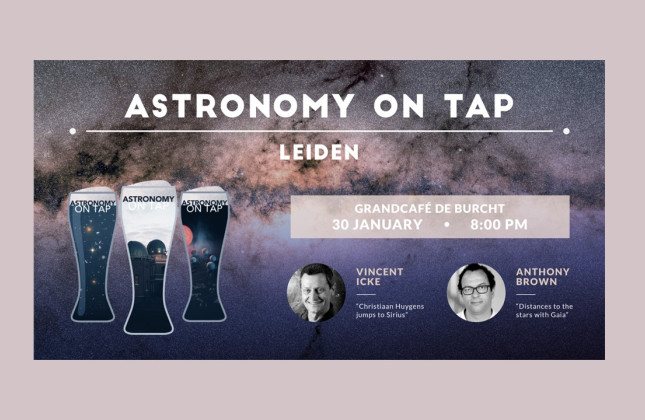Astronomy on Tap: Distances to the Stars: From Huygens to Gaia (Leiden, in English)
The next Astronomy on Tap Leiden will take place on Monday 30 January at Grand Café de Burcht at 20:00 CET. Visit the event for a night of astronomy with talks from Leiden professors Vincent Icke and Anthony Brown. They will tell the audience about how astronomers measure distances to the stars: from 350 years ago when Huygens attempted to measure the distance to Sirius to modern day measurements with the Gaia spacecraft. As always, there will be fun games where you could win cool science prizes
Vincent Icke: Christiaan Huygens jumps to Sirius
Vincent Icke is professor of theoretical astrophysics at Universiteit Leiden, and visual artist. After his master’s degree in theoretical physics and astronomy at Utrecht, he obtained a doctorate at Leiden on the origin of clusters of galaxies. He worked for four years as a postdoc in Cambridge (UK), two years at Caltech (USA), and five years as assistant professor at the University of Minnesota (USA). Besides his academic and artistic work, Vincent Icek presents science to the general public, for example in his recent books "Reisbureau Einstein" and "Licht. Tussen waarheid en wetenschap". He appears regularly on radio and television. He wrote three books about Christiaan Huygens, and a fourth is in preparation.
About this talk: Around 260 BC, Aristarchos of Samos proposed that Earth is a sphere orbiting the Sun, and that the stars are distant suns. A serious objection was: in that case, we should see the positions of the stars wobble in the sky, because Earth moves. The first telescopic observation of this wobble, called 'parallax', was made by Friedrich Bessel in 1838. However, around the year 1670 Christiaan Huygens - with his usual flash of genius - already made a superb estimate of the distance to Sirius, without a telescope. How did he do that?
Anthony Brown: Distances to the stars with Gaia
Anthony Brown is associate professor at Leiden Observatory and has been involved in the European Space Agency's Gaia mission since 1997. He currently chairs the Gaia Data Processing and Analysis Consortium, a team of over 400 European astronomers and IT specialists who are in charge of turning the raw measurements from the Gaia spacecraft into a three dimensional map of over one billion stars in our home galaxy, the Milky Way. Anthony is very broadly interested in the astronomical research that can be done with the aid of Gaia data, from studies of our own solar system to understanding the formation history of the Milky Way.
In this talk, Anthony will discuss how precise geometric distances to stars are measured with Gaia and end with the question "Is Huygens' method now obsolete?"
Logistical information
Astronomy on Tap Leiden starts at 20:00 sharp, so please arrive earlier to enter the bar, save a seat, and grab a drink. The organisation is not planning to stream the event live, but they will be uploading a recording of the talks on our YouTube channel after the event.
For more information check out http://astronomyontap.nl/
